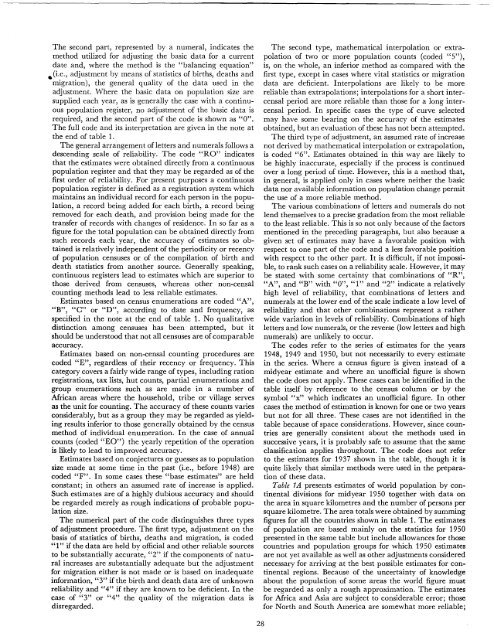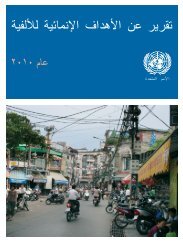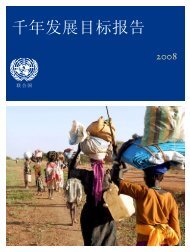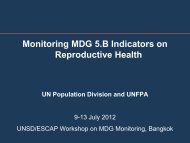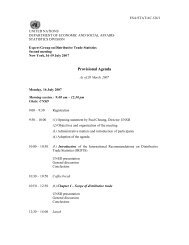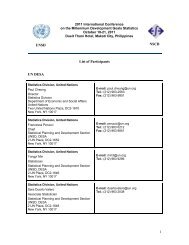demographic yearbook annuaire demographique 1951
demographic yearbook annuaire demographique 1951
demographic yearbook annuaire demographique 1951
You also want an ePaper? Increase the reach of your titles
YUMPU automatically turns print PDFs into web optimized ePapers that Google loves.
The second part, represented by a numeral, indicates the<br />
method utilized for adjusting the basic data for a current<br />
date and, where the method is the "balancing equation"<br />
• (i.e., adjustment by means of statistics of births, deaths and<br />
migration), the general quality of the data used in the<br />
adjustment. Where the basic data on population size are<br />
supplied each year, as is generally the case with a continuous<br />
population register, no adjustment of the basic data is<br />
required, and the second part of the code is shown as "0".<br />
The full code and its interpretation are given in the note at<br />
the end of table 1.<br />
The general arrangement of letters and numerals follows a<br />
descending scale of reliability. The code "RO" indicates<br />
that the estimates were obtained directly from a continuous<br />
population register and that they may be regarded as of the<br />
first order of reliability. For present purposes a continuous<br />
population register is defined as a registration system which<br />
maintains an individual record for each person in the population,<br />
a record being added for each birth, a record being<br />
removed for each death, and provision being made for the<br />
transfer of records with changes of residence. In so far as a<br />
figure for the total population can be obtained directly from<br />
such records each year, the accuracy of estimates so obtained<br />
is relatively independent of the periodicity or recency<br />
of population censuses or of the compilation of birth and<br />
death statistics from another source. Generally speaking,<br />
continuous registers lead to estimates which are superior to<br />
those derived from censuses, whereas other non-censal<br />
counting methods lead to less reliable estimates.<br />
Estimates based on census enumerations are coded "A",<br />
"B", "c" or "D", according to date and frequency, as<br />
specified in the note at the end of table 1. No qualitative<br />
distinction among censuses has been attempted, but it<br />
should be understood that not all censuses are ofcomparable<br />
accuracy.<br />
Estimates based on non-censal counting procedures are<br />
coded "E", regardless of their recency or frequency. This<br />
category covers a fairly wide range of types, including ration<br />
registrations, tax lists, hut counts, partial enumerations and<br />
group enumerations such as are made in a number of<br />
Mrican areas where the household, tribe or village serves<br />
as the unit for counting. The accuracy of these counts varies<br />
considerably, but as a group they may be regarded as yielding<br />
results inferior to those generally obtained by the census<br />
method of individual enumeration. In the case of annual<br />
counts (coded "EO") the yearly repetition of the operation<br />
is likely to lead to improved accuracy.<br />
Estimates based on conjectures or guesses as to population<br />
size made at some time in the past (i.e., before 1948) are<br />
coded "F". In some cases these "base estimates" are held<br />
constant; in others an assumed rate of increase is applied.<br />
Such estimates are of a highly dubious accuracy and should<br />
be regarded merely as rough indications of probable population<br />
size.<br />
The numerical part of the code distinguishes three types<br />
of adjustment procedure. The first type, adjustment on the<br />
basis of statistics of births, deaths and migration, is coded<br />
"1" if the data are held by official and other reliable sources<br />
to be substantially accurate, "2" if the components of natural<br />
increases are substantially adequate but the adjustment<br />
for migration either is not made or is based on inadequate<br />
information, "3" if the birth and death data are of unknown<br />
reliability and "4" if they are known to be deficient. In the<br />
case of "3" or "4" the quality of the migration data is<br />
disregarded.<br />
The second type, mathematical interpolation or extrapolation<br />
of two or more population counts (coded "5"),<br />
is, on the whole, an inferior method as compared with the<br />
first type, except in cases where vital statistics or migration<br />
data are deficient. Interpolations are likely to be more<br />
reliable than extrapolations; interpolations for a short intercensal<br />
period are more reliable than those for a long intercensal<br />
period. In specific cases the type of curve selected<br />
may have some bearing on the accuracy of the estimates<br />
obtained, but an evaluation of these has not been attempted.<br />
The third type of adjustment, an assumed rate of increase<br />
not derived by mathematical interpolation or extrapolation,<br />
is coded "6". Estimates obtained in this way are likely to<br />
be highly inaccurate, especially if the process is continued<br />
over a long period of time. However, this is a method that,<br />
in general, is applied only in cases where neither the basic<br />
data nor available information on population change permit<br />
the use of a more reliable method.<br />
The various combinations of letters and numerals do not<br />
lend themselves to a precise gradation from the most reliable<br />
to the least reliable. This is so not only because of the factors<br />
mentioned in the preceding paragraphs, but also because a<br />
given set of estimates may have a favorable position with<br />
respect to one part of the code and a less favorable position<br />
with respect to the other part. It is difficult, if not impossible,<br />
to rank such cases on a reliability scale. However, it may<br />
be stated with some certainty that combinations of "R",<br />
"A", and "B" with "a", "1" and "2" indicate a relatively<br />
high level of reliability, that combinations of letters and<br />
numerals at the lower end of the scale indicate a low level of<br />
reliability and that other combinations represent a rather<br />
wide variation in levels of reliability. Combinations of high<br />
letters and low numerals, or the reverse (low letters and high<br />
numerals) are unlikely to occur.<br />
The codes refer to the series of estimates for the years<br />
1948, 1949 and 1950, but not necessarily to every estimate<br />
in the series. Where a census figure is given instead of a<br />
midyear estimate and where an unofficial figure is shown<br />
the code does not apply. These cases can be identified in the<br />
table itself by reference to the census column or by the<br />
symbol "x" which indicates an unofficial figure. In other<br />
cases the method of estimation is known for one or two years<br />
but not for all three. These cases are not identified in the<br />
table because of space considerati~ns.However, since countries<br />
are generally consistent about the methods used in<br />
successive years, it is probably safe to assume that the same<br />
classification applies throughout. The code does not refer<br />
to the estimates for 1937 shown in the table, though it is<br />
quite likely that similar methods were used in the preparation<br />
of these data.<br />
Table lA presents estimates of world population by continental<br />
divisions for midyear 1950 together with data on<br />
the area in square kilometres and the number of persons per<br />
square kilometre. The area totals were obtained by summing<br />
figures for all the countries shown in table 1. The estimates<br />
of population are based mainly on the statistics for 1950<br />
presented in the same table but include allowances for those<br />
countries and population groups for which 1950 estimates<br />
are not yet available as well as other adjustments considered<br />
necessary for arriving at the best possible estimates for continental<br />
regions. Because of the uncertainty of knowledge<br />
about the population of some areas the world figure must<br />
be regarded as only a rough approximation. The estimates<br />
for Mrica and Asia are subject to considerable error; those<br />
for North and South America are somewhat more reliable;<br />
28


